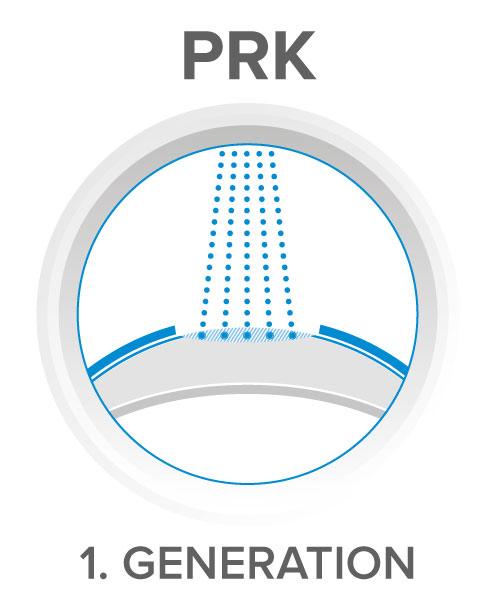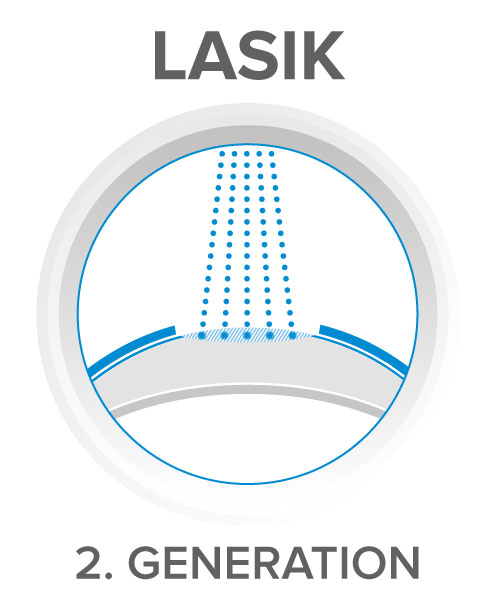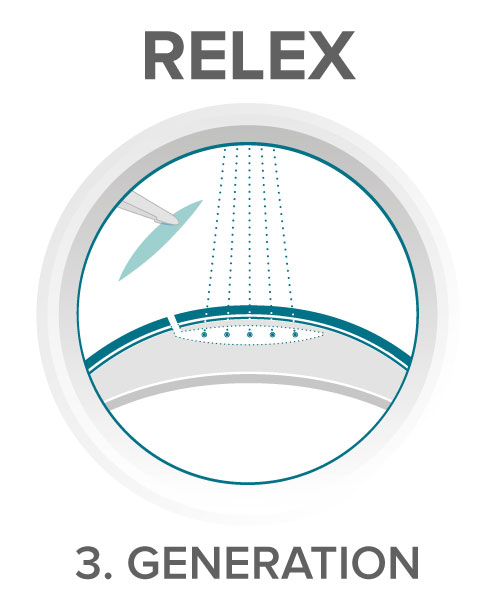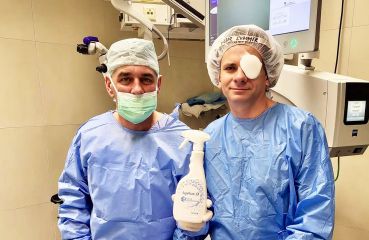Differences between individual laser surgery methods
As things evolve and change in our lives, the technologies and lasers that are used in laser eye surgery are evolving too. Frankly put this is very good and fortunate for the patient. With this development, we have progressed from the 1st generation of laser surgery, which have been and still are painful to the 3rd generation of laser surgery which guarantees you not only an absolutely painless procedure but also no pain whatsoever after the procedure. However, you will immediately have your sight sharp.
The basis for any dioptre correction with laser surgery is the change in thickness and curvature of the cornea. Using the laser, the thickness and curvature of the cornea are modified to provide the patient with perfect sight. The difference between the different methods lies in the procedure we use to change these corneal parameters.

PRK (photorefractive keratectomy) is the oldest method, the so-called first generation of laser eye surgery. It is a surface method that corrects a dioptric error by altering the curvature of the cornea in myopia and astigmatism. The procedure is performed on the surface of the eye without creating a protective corneal lamella.

Anaesthetic drops will be applied first followed by a two-step surgery procedure. The ophthalmic surgeon first removes the corneal epithelium (the surface area of the eye, roughly 50 μm) mechanically without the use of any alcohol solution. The next step is the adjustment of the cornea into the desired form by means of an excimer laser and correction of the dioptric error. The ophthalmic surgeon then applies a contact lens on the cornea for a period of 4-5 days, helping the eye to heal and the epithelium to grow on the surface of the cornea. After 4-5 days this protective lens is removed from the eye. The entire procedure takes about 15 minutes.
The disadvantage of the PRK surgery method is the sensitivity and photophobia for 3-4 days after surgery. There is also a risk of dry eye syndrome and inflammation. Steady vision comes within a few weeks after the surgery.
As this is the oldest type of surgery, this method is one of the cheapest and least comfortable methods of laser eye surgery.
The LASEK method is a modified PRK technique procedure.
At our clinic, this is not recommended due to the availability of more advanced, newer and safer methods and new faster laser equipment. We rather offer our patients different funding options.

LASIK or as we say Z-LASIK is the second generation laser eye surgery. It is a very popular depth procedure, which means, that it does not damage the corneal epithelium. It is very gentle on your eyes and painless even after the anaesthesia wears off. Two lasers - femtosecond and excimer - are used to correct the dioptric error. This method is designed to eliminate myopia, long-sightedness and astigmatism.

Before the procedure, you will anaesthetize our eyes with anaesthetic drops. The next step in this laser surgery method is the creation of a corneal lamella using a femtosecond laser, with the ophthalmic surgeon folding the cornea aside and applying the excimer laser which adjusts the cornea surface in a way to remove the dioptric error. The last step is to folding the corneal lamella back into place. The same procedure is applied in case of the other eye. Immediately after the surgery, you may feel a slight burning and blurred vision, but it is a completely normal condition that quickly wears off. The onset of sharp vision occurs, in the majority of our patients, just a few hours after the surgery (up to 24).
The first couple of days after the surgery, you should have a calmer Schedule and avoid any sports activities. In rare cases, a dry eye syndrome occurs when artificial tears need to be applied.
 Relex Smile is the state-of-the-art method and so-called 3rd generation of laser eye surgery. It is one of the deep surgical procedures, which means that the eye correction takes place inside the cornea, making the procedure more gentle and associated with a much lower risk of complications compared to the surface methods. It does not disturb the natural properties of the cornea and is also absolutely painless. Thanks to the advanced technology and skilled hands of our specialists, it has the most stable results among all surgical methods. It is an ideal choice for patients with short-sightedness up to -10 dioptre and astigmatism up to 5 cylinders.
Relex Smile is the state-of-the-art method and so-called 3rd generation of laser eye surgery. It is one of the deep surgical procedures, which means that the eye correction takes place inside the cornea, making the procedure more gentle and associated with a much lower risk of complications compared to the surface methods. It does not disturb the natural properties of the cornea and is also absolutely painless. Thanks to the advanced technology and skilled hands of our specialists, it has the most stable results among all surgical methods. It is an ideal choice for patients with short-sightedness up to -10 dioptre and astigmatism up to 5 cylinders.
As is the case with the first two surgical methods, the eyes are first anaesthetized with anaesthetic drops. Using the femtosecond laser Visumax 500, a so-called lenticle (microscopic lens) is created within the cornea and is then pulled out of the cornea through a 3mm microscopic cut. This changes the dioptric strength of the cornea by a precisely calculated value. The laser action itself takes only a few tens of seconds. Another advantage is that the excimer laser is not used in this method, thus there is no burning of corneal tissue present.

The femtosecond laser first creates a lenticle within the cornea, and later an opening through which the lenticle is pulled out by the ophthalmic surgeon.
Thanks to this treatment being very gentle, you will not need any recovery time, and you can quickly get back to your hobbies or favourite sports. At the same time, there is a minimal risk of developing dry eye syndrome or the need for using artificial tears after the surgery.
Eye surgery with this method is painless, and you will not feel any pain even after the procedure itself. A new look at the world with sharp vision without glasses or lenses awaits you right after the surgery.
The basis for any dioptre correction with laser surgery is the change in thickness and curvature of the cornea. Using the laser, the thickness and curvature of the cornea are modified to provide the patient with perfect sight. The difference between the different methods lies in the procedure we use to change these corneal parameters.

PRK (photorefractive keratectomy) is the oldest method, the so-called first generation of laser eye surgery. It is a surface method that corrects a dioptric error by altering the curvature of the cornea in myopia and astigmatism. The procedure is performed on the surface of the eye without creating a protective corneal lamella.

What is the procedure of the surgery?
Anaesthetic drops will be applied first followed by a two-step surgery procedure. The ophthalmic surgeon first removes the corneal epithelium (the surface area of the eye, roughly 50 μm) mechanically without the use of any alcohol solution. The next step is the adjustment of the cornea into the desired form by means of an excimer laser and correction of the dioptric error. The ophthalmic surgeon then applies a contact lens on the cornea for a period of 4-5 days, helping the eye to heal and the epithelium to grow on the surface of the cornea. After 4-5 days this protective lens is removed from the eye. The entire procedure takes about 15 minutes.
The disadvantage of the PRK surgery method is the sensitivity and photophobia for 3-4 days after surgery. There is also a risk of dry eye syndrome and inflammation. Steady vision comes within a few weeks after the surgery.
As this is the oldest type of surgery, this method is one of the cheapest and least comfortable methods of laser eye surgery.
The LASEK method is a modified PRK technique procedure.
At our clinic, this is not recommended due to the availability of more advanced, newer and safer methods and new faster laser equipment. We rather offer our patients different funding options.

LASIK or as we say Z-LASIK is the second generation laser eye surgery. It is a very popular depth procedure, which means, that it does not damage the corneal epithelium. It is very gentle on your eyes and painless even after the anaesthesia wears off. Two lasers - femtosecond and excimer - are used to correct the dioptric error. This method is designed to eliminate myopia, long-sightedness and astigmatism.

What is the procedure of the surgery?
Before the procedure, you will anaesthetize our eyes with anaesthetic drops. The next step in this laser surgery method is the creation of a corneal lamella using a femtosecond laser, with the ophthalmic surgeon folding the cornea aside and applying the excimer laser which adjusts the cornea surface in a way to remove the dioptric error. The last step is to folding the corneal lamella back into place. The same procedure is applied in case of the other eye. Immediately after the surgery, you may feel a slight burning and blurred vision, but it is a completely normal condition that quickly wears off. The onset of sharp vision occurs, in the majority of our patients, just a few hours after the surgery (up to 24).
The first couple of days after the surgery, you should have a calmer Schedule and avoid any sports activities. In rare cases, a dry eye syndrome occurs when artificial tears need to be applied.

What is the procedure of the surgery?
As is the case with the first two surgical methods, the eyes are first anaesthetized with anaesthetic drops. Using the femtosecond laser Visumax 500, a so-called lenticle (microscopic lens) is created within the cornea and is then pulled out of the cornea through a 3mm microscopic cut. This changes the dioptric strength of the cornea by a precisely calculated value. The laser action itself takes only a few tens of seconds. Another advantage is that the excimer laser is not used in this method, thus there is no burning of corneal tissue present.

The femtosecond laser first creates a lenticle within the cornea, and later an opening through which the lenticle is pulled out by the ophthalmic surgeon.
Thanks to this treatment being very gentle, you will not need any recovery time, and you can quickly get back to your hobbies or favourite sports. At the same time, there is a minimal risk of developing dry eye syndrome or the need for using artificial tears after the surgery.
Eye surgery with this method is painless, and you will not feel any pain even after the procedure itself. A new look at the world with sharp vision without glasses or lenses awaits you right after the surgery.













